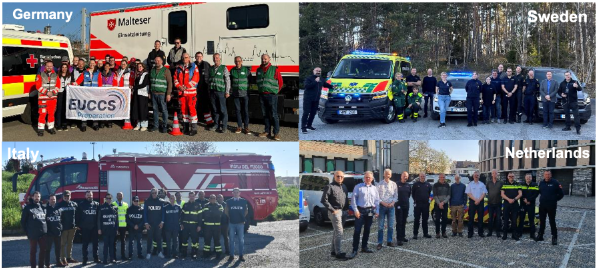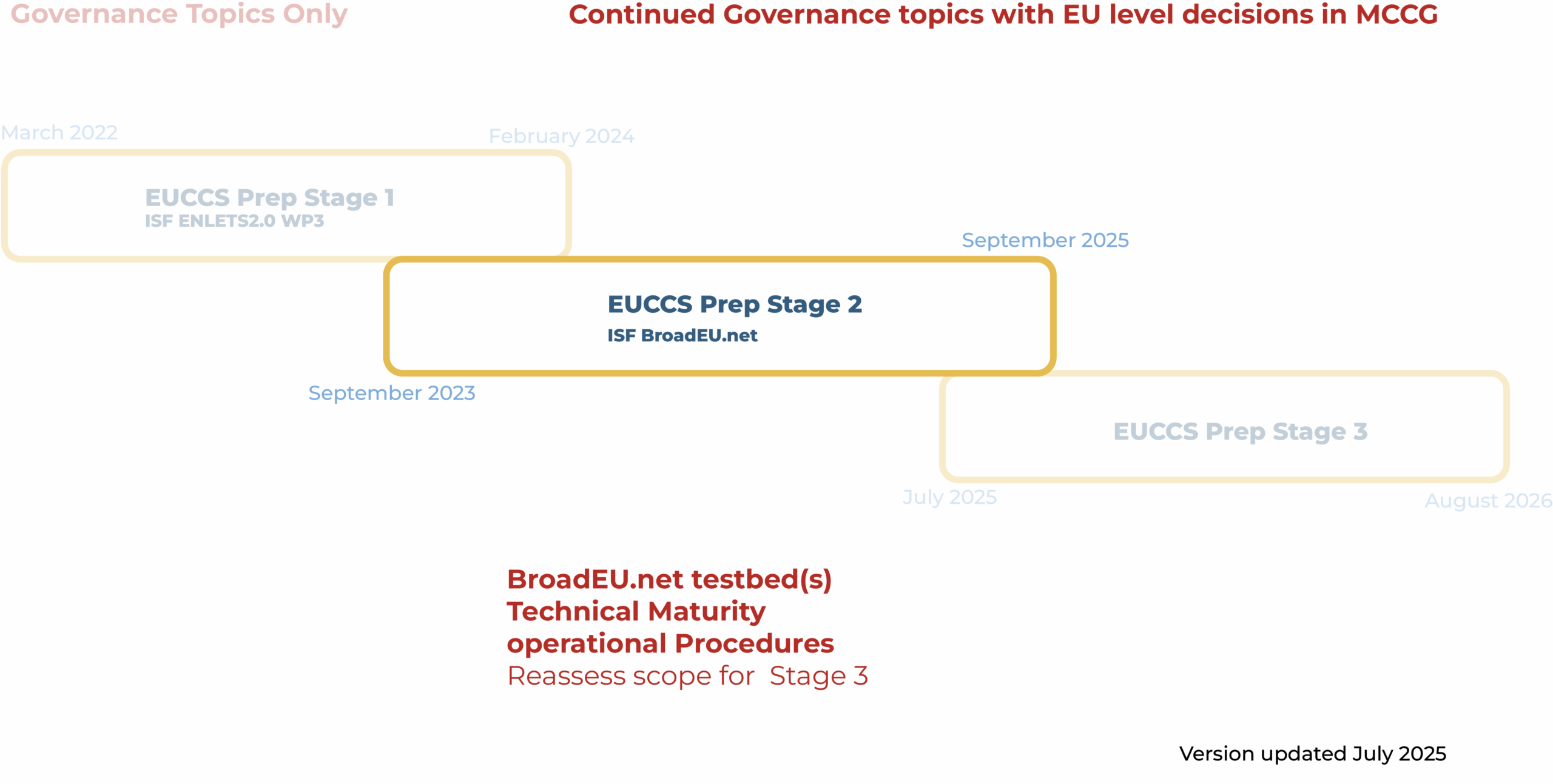31 July 2025
Contracts for Stage 2 began in 2024, following a public procurement process earlier in the year.
MCX Servers, User devices and applications are procured. Connectivity is provided by commercial mobile services, so we don’t focused on QPP (quality, priority, pre-emption) at this time. We focus mainly towards gaining an understanding the maturity and utility of the MCX technology, and how services will be used by operational responders. Our Operational Procedures Team (OPT) will consider how new or adapted Operational Procedures will be developed to support operational use of MCX services and applications in a pan-European context.
4 Contractors are each tasked to provide Mission Critical Services for 2 countries. In total, 8 countries:

3 Milestones are achieved between January and June 2025.

Each contractor provides 2 different models of user devices, MCX applications, and 2 MCX services for management by 2 National Test Management (NTM) authorities; our partners representing the national mobile broadband preparations towards implementation of MCX mobile broadband deployment in their country.
This is the first opportunity for our NTM authorities and OPT to become familiar with the technology. Contractors provide training on how to operate the technology.

Each contractor interconnects the 2 MCX servers that they have provided for 2 countries. Communication (Talk) groups in each country can be patched together. Further training is provided.
We learn how:
Active dialogue and feedback to contractors is given on what can be improved.

Each contractor interconnects their MCX servers with the MCX server of 1 other contractor.
Communication (Talk) groups can be patched together between at least 3 countries.
We learn how:

This is an internal team of practitioners representing 10 countries, lead by Bavarian Red Cross. It works with an external team of volunteer operational practitioners from across Europe. The overall goals of this team’s work is to:

OPT Table Top Exercises
Scenario : traffic accident at border
A series of table-top exercises were organised to elaborate the current problems of communication in cross-border response as well as the ideal vision for what cross-border communication and related operational procedures should be in the future. In addition, they were designed to explore how MCX technologies could create beneficial change in collaboration and communication. Table top play was without technology in order to establish the necessary foundation for learning and evaluation.
The aim was to understand:
Scenario: traffic accident at border area
With the participation of operational responders from different countries and agencies, a series of online table-top exercises were held. Immediate insights revolved around the need to:
New ideas already began to emerge as to how interconnected MCX technology can support newer and faster information gathering from the scene as well as to what ‘quality’ communication might involve.

Scenario: flooding in border area
A series of activities centred around table-top exercises explored both how to work in a flooding scenario and how communication needs could change in different disaster or crisis scenarios. Participants across the two exercises included 26 responder representatives from eight different countries covering Fire, Rescue, and Police.
Areas identified of greatest impact for MCX and operational procedures included:

Scenario: flooding in border area
The first Pilot Trial was actually four different events that took place around the same time in four different countries, each running the same scenario. Participants were provided with with interconnected devices with the objectives both to assess how operational mobility might improve and better to understand the different needs across agencies and countries. Responders participated from police, fire, rescue, water rescue, mountain rescue, and K9. Each trial had at least 13 responders participating as players.
The aim, primarily, was to test the hypotheses from the table top exercises but also to:
Overall, being able to talk with responders from other countries tasked to the same incident was easier and participants saw the potential value for sharing information in new ways to build more effective shared situational awareness. But it also became evident that there would be no one-size-fits-all solution and that there will be different informational needs depending on the role and current operational situation. For the technology to be effective, a strong framework for operational procedures that includes as much pre-definition as possible will be needed.

Scenario: multi-national sea and land drug chase
This pilot trial brought together 20 responders from seven countries representing different agencies to play an exercise scenario that involved actors and activity than spanned three different countries. Participants included:
Overall 62 people attended, including technical colleagues and observers.
Participants saw improvement in collaboration across actors and countries because it allowed direct contact with relative ease. They also saw the value in sharing data, particularly photos, videos, text and location, demonstrating the potential to reduce workload. But, it became evident that just having technology that enables communication isn’t enough; the solutions need to be organised to support communication flows in practice. Working with these systems helped participants better articulate how they would like to work and what they expected, as they clarify their visions for the MCX tools, further identify gaps and needs, and improve their ability to articulate how they ideally want to communicate.

Inspired by trial participants from An Garda Síochána (Irish Police) and a previous operation they were involved in.
